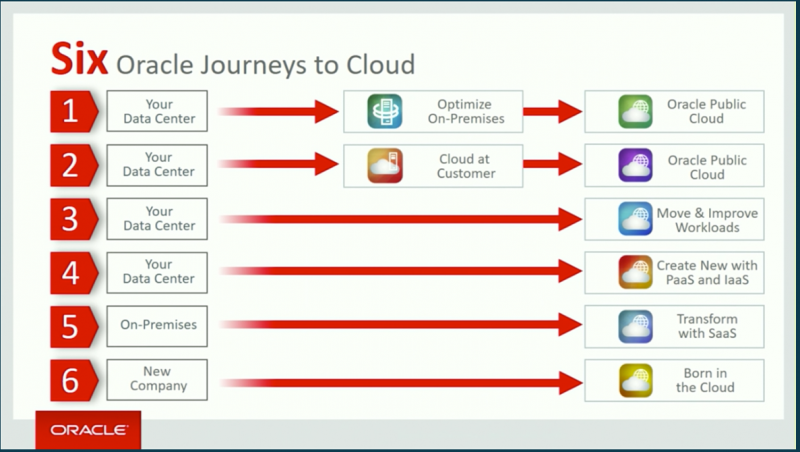 CLOUD
CLOUD
 CLOUD
CLOUD
 CLOUD
CLOUD
Hoping to claw a path into leadership in cloud computing, Oracle Corp. today announced a raft of upgrades to its infrastructure-as-a-service offering, spanning computing, storage and networking.
The goal is to provide better cloud performance for the largest enterprises, many of which still haven’t moved most of their operations out of their own data centers partly because of uncertainties about the speed and reliability of the cloud — especially for running Oracle’s own workhorse database. Thomas Kurian (pictured), Oracle’s president of product development, outlined five major improvements for the foundation layer of the Oracle Cloud at a morning keynote at the company’s OpenWorld customer conference in San Francisco.
For one, Oracle introduced a new system architecture called X7 and offered a new line of computing instances running on top of it. In particular, it’s offering cloud versions of so-called “bare metal” servers that have no software pre-installed on them so customers can quickly configure them and change that configuration as they choose. “Oracle is the only one with bare metal,” Leo Leung, an Oracle director of product management, told SiliconANGLE.
These bare-metal computing instances now are offered with 52 processing cores, up from 36 before, with more memory and much higher flash-memory block storage. Also new are more processor tiers for virtual machines, which are used to allow multiple versions of physical machines emulated in software to run on one machine. All that’s aimed at demanding applications such as simulations, computational fluid dynamics, analytics and high-end enterprise applications.
Taking the compute improvements together, Oracle claims, computing performance is 87 percent better, with 54 percent better price-performance compared with major cloud providers such as Amazon Web Services Inc. and Microsoft Corp.’s Azure, at least on a particular standard measure of performance.
In addition, Oracle introduced bare-metal instances using graphics processing unit chips from Nvidia Corp. that have become the standard way to do intensive applications involving machine learning. Oracle claims the instances are up to five times faster than rivals’ running the TensorFlow deep-learning framework software and a computer vision model, while costing 58 percent less. “This really expands the portfolio,” Leung said.
Among a flurry of other announcements, Oracle also debuted faster all-flash block storage, a new archive storage service, a faster networking infrastructure and a data transfer appliance for moving important huge amounts of data into Oracle’s cloud faster and less expensively than can be done over the Internet — that last similar to AWS’s Snowball.
Overall, “we have set the pricing pressure,” Kash Iftikhar, Oracle’s vice president for IaaS, said in a recent interview with SiliconANGLE. “We have the applications and we understand the enterprise really well. Now it’s all about execution.”
Leung acknowledged that Oracle remains far behind the cloud leaders, at least in the base-level IaaS, and even behind some of the laggards such as IBM Corp. But he said Oracle believes the move to the cloud has just begun, and that vast majority of workloads will be coming from traditional large enterprises rather than the startups — small or overgrown such as Uber Technologies Inc. — that started mostly in the cloud.
 “The vast majority of production workloads have not moved off-prem yet,” Leung said. “Competitors are pushing toward the new new new,” but often require applications to be changed to move to the cloud.
“The vast majority of production workloads have not moved off-prem yet,” Leung said. “Competitors are pushing toward the new new new,” but often require applications to be changed to move to the cloud.
Indeed, cloud watchers say Oracle’s best bet is to keep its existing customers by giving them an easy path to the cloud. “But the jury’s still out,” said Doug Henschen, vice president and principal analyst at Constellation Research Inc., because Oracle’s infrastructure as a service has not really penetrated the overall market to a significant degree.
Leung conceded that “if we maintain the same pace of innovation, we’ll fall behind. So we have to accelerate our pace of innovation.” He said Oracle has added more than 50 infrastructure enhancements in the past year and want to double that pace for each of the next two years.
Oracle founder and Chief Technology Officer Larry Ellison appears to have tacitly conceded that IaaS is table stakes for a larger move of databases and applications to the cloud, areas where Oracle may have more luck. But if it can’t at least get customers to use its IaaS foundation, he may yet lose too many of them.
“Ellison is burning to go down in history as a great leader and he’s got to find away to sustain Oracle through this transformation and get it to the next generation,” said Peter Burris, chief research officer at Wikibon, the analyst group owned by the same company as SiliconANGLE. “This is the year that it’s no longer about transforming, but executing on this new path.”
THANK YOU